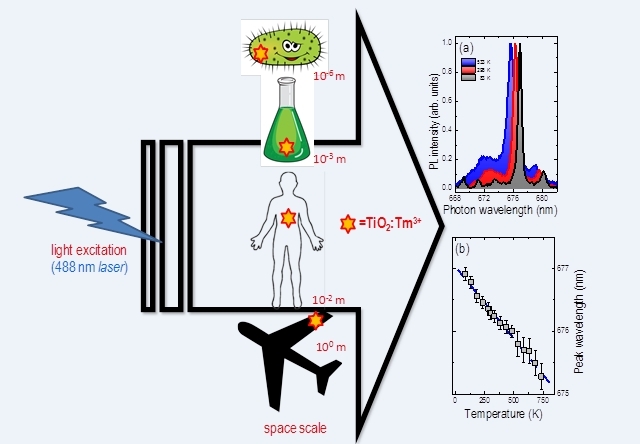

Material developed in Brazil measures temperatures in the range of 80-750 kelvin (-193 °C to 476 °C) and, as described in Scientific Reports, could be used in manufacturing and biological processes (image: researchers' archive)
Material developed in Brazil measures temperatures in the range of 80-750 kelvin (-193 °C to 476 °C) and, as described in Scientific Reports, could be used in manufacturing and biological processes.
Material developed in Brazil measures temperatures in the range of 80-750 kelvin (-193 °C to 476 °C) and, as described in Scientific Reports, could be used in manufacturing and biological processes.

Material developed in Brazil measures temperatures in the range of 80-750 kelvin (-193 °C to 476 °C) and, as described in Scientific Reports, could be used in manufacturing and biological processes (image: researchers' archive)
By José Tadeu Arantes | Agência FAPESP – Can a “thermometer” consist of a thin film or tiny (micrometer or even nanometer scale) particles, operate in real time and in very well-defined regions with a spatial resolution ranging from a centimeter to a micrometer, and be capable of measuring temperatures with exceptional sensitivity in a wide band between 80 kelvin (minus 193 °C) and 750 kelvin (476 °C)? The answer is yes.
A temperature sensor with practically no effect at all on the temperature of the object measured has been created in the laboratory by researchers at the University of São Paulo (USP) and the University of Campinas (UNICAMP) in São Paulo State, Brazil, and is awaiting a patent for commercial production.
The sensor is described in an article in Scientific Reports. The researchers responsible are Fernando Alvarez and Diego Scoca, affiliated with UNICAMP’s Gleb Wataghin Physics Institute, and Antonio Ricardo Zanatta, affiliated with USP’s São Carlos Physics Institute. The research is supported by FAPESP through the Thematic Project “Research and development of nanostructured materials for electronic and surface physics applications”, with Alvarez as principal investigator.
“The temperature sensor consists of a system made of titanium dioxide (TiO2) doped with thulium ions (Tm3+). Because it’s capable of measuring a very broad spectrum of temperatures, it can be used in manufacturing – where temperatures sometimes reach very high levels – as well as biological processes, which are highly sensitive to the slightest temperature variations,” Alvarez told Agência FAPESP.
When excited by a laser pulse, the material emits light at wavelengths that vary depending on the temperature of the environment. A very precise measurement of the wavelength is used to determine this temperature.
“Variation in the wavelength of the emitted light is absolutely linear between 80 and 750 kelvin, and the device remains integral and stable throughout this temperature range,” Zanatta said. “At this stage, we’ve arranged the material in the form of a thin film. Theoretically, this can be used as a coating for any surface, be it flat or curved, smooth or rough. The material can also be presented as microparticles or nanoparticles.”
Although this technological development does not yet exist, in principle, it would be possible to encapsulate the laser emitter, temperature sensor and wavelength detector with a radio communicator inside a small pill.
Swallowed with a little water, the pill would send back temperature data while moving along the digestive tract until its ejection from the organism at the opposite extremity: a futuristic scenario, but not too distant from the science available now.
“A very simple application, which could rapidly be made feasible, would entail coating a plastic substrate with the sensor and fixing it to a patient’s skin. It’s important to note that titanium dioxide is abundant, easy to obtain, and biocompatible, i.e., non-toxic. It’s already used in many medical prosthetic devices,” Alvarez said.
Other potential applications of the sensor range from the identification of hotspots in electronic equipment to the detection of viral or bacterial infection in specific regions of an organism.
As a thin film, the material can be as small as a few square centimeters or reach several square meters for use as a surface coating on components of land vehicles, aircraft or power grid transformers. As micrometric or nanometric particles, it can be dispersed in a liquid medium while remaining solid.
A patent application form commercial production has been filed with support from UNICAMP’s incubator, the Inova UNICAMP.
“Because the device is optical, information on the temperature of the object of interest can be obtained without direct physical contact between them,” Zanatta said. “It suffices to project a laser beam onto the sensor and observe how it responds. By measuring the wavelength of the light emitted by the sensor using a detector, the temperature of the object can be determined with great precision.”
The wavelength varies approximately 2 picometers (2x10-12 m) per degree of temperature. Spectroscopy can be used to detect this tiny wavelength variation. However, the need for a dedicated detector is a limiting factor at the present stage, in terms of both the cost and portability of the device.
“The associated instrumentation is costly today, given the need for a laser and a detector,” Zanatta said. “We believe, however, that as technology advances, it will be possible to fabricate an integrated device with a semiconductor laser, temperature sensor and detector. And the cost can be considerably reduced when we go from laboratory to industrial scale.”
The article “A suitable (wide-range + linear) temperature sensor based on Tm3+ ions” (doi:10.1038/s41598-017-14535-1) by A. R. Zanatta, D. Scoca and F. Alvarez can be read at nature.com/articles/s41598-017-14535-1.epdf.
Republish
The Agency FAPESP licenses news via Creative Commons (CC-BY-NC-ND) so that they can be republished free of charge and in a simple way by other digital or printed vehicles. Agência FAPESP must be credited as the source of the content being republished and the name of the reporter (if any) must be attributed. Using the HMTL button below allows compliance with these rules, detailed in Digital Republishing Policy FAPESP.





